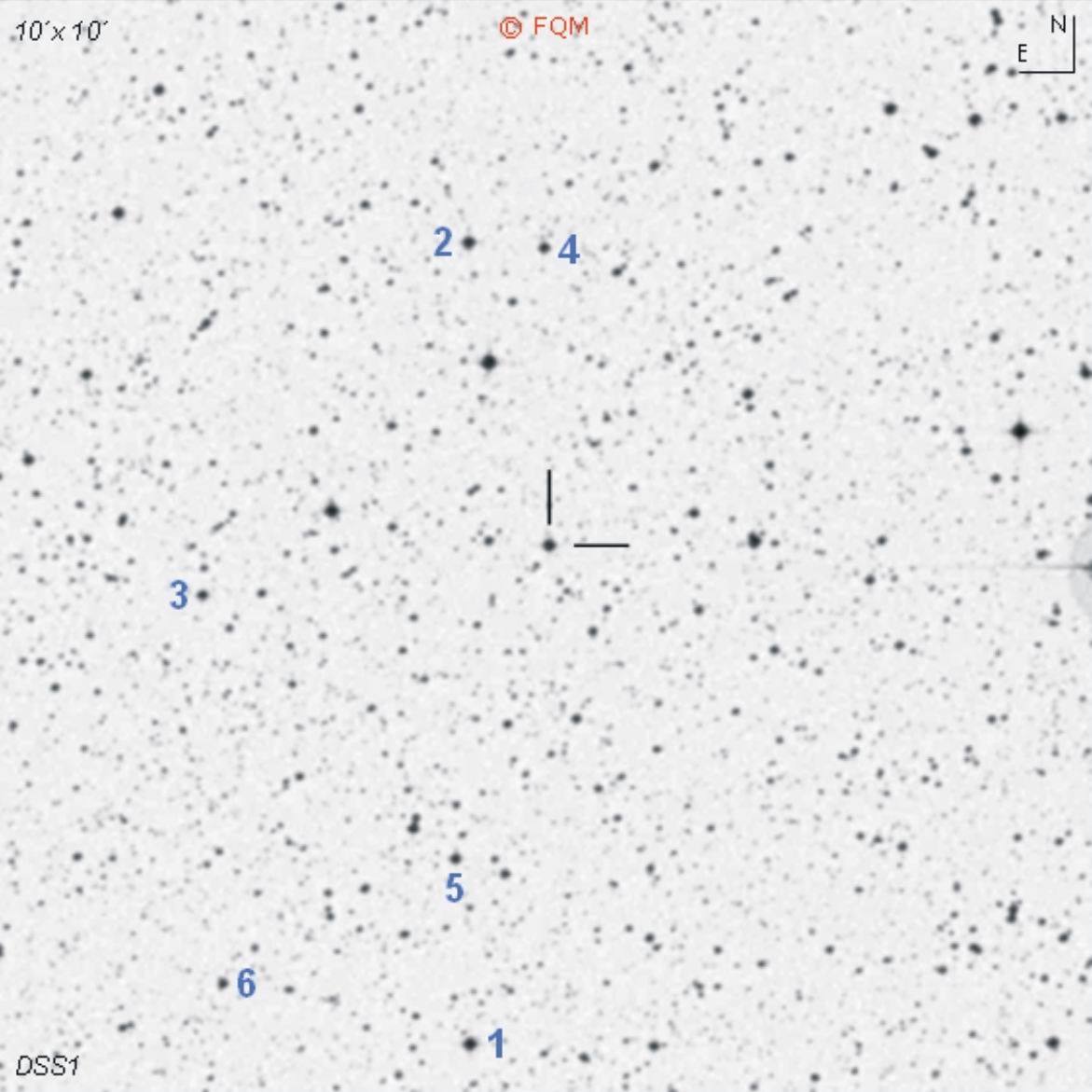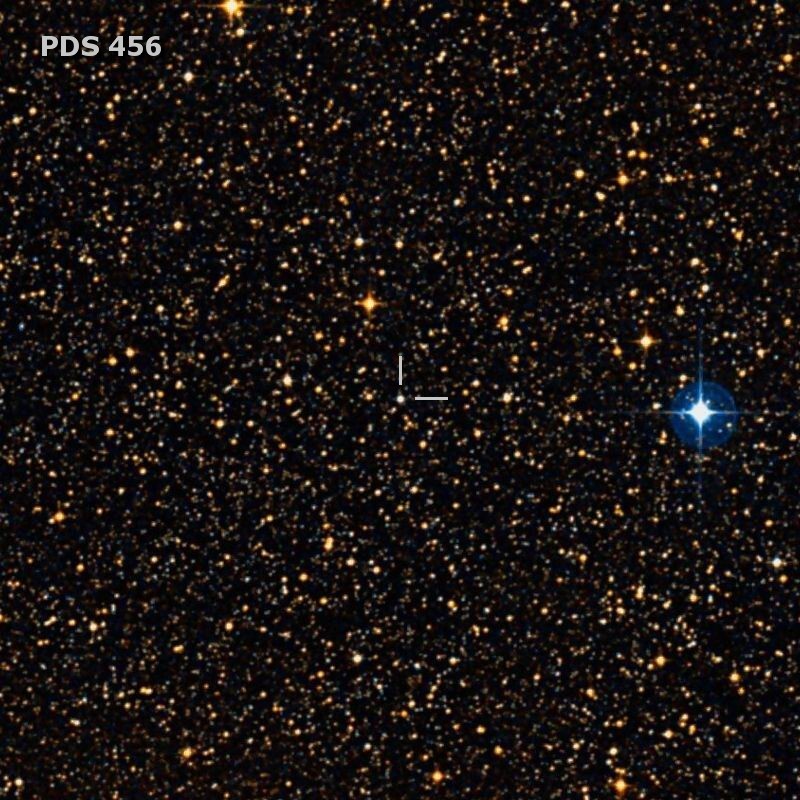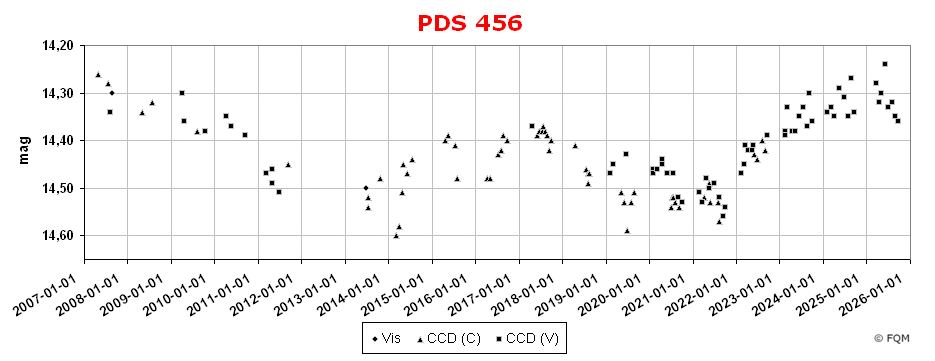
| Frankfurt Quasar Monitoring |
| PDS 456 |
| Cross-Identifications | QSO J1728-1415, IRAS 17254-1413, 1725-142 1RXS J172819.3-141600, 1AXG J172818-1415 XSS J17276-1359, 2XMM J172819.7-141555 NVSS J172819-141554, QSO B1725-142 1AXG J172818-1415, QSO J1728-1415 WISEA J172819.79-141555.8 |
| Equat. coordinates | RA 17 28 19.8 DE -14 15 55 (J2000) |
| Constellation | Serpens (Cauda) |
| Type |
QSO |
| Redshift (1) (6) | z=0.184 |
|
Distance
(2)
(3) |
726 Mpc |
| Total mag range (mv) (4) (5) | 14.0 - 14.5 |
| Catalog Magnitude | 14.03 (1) / 14.69 B (6) |
| Absolute Magnitude (1) | -25.6 MB |
| Light Travel-Time (2) | 2.177 × 109 yrs |

Comparison stars
| star | B | V |
| 1 | 14.297 (0.058) |
13.497 (0.020) |
| 2 | 14.547 (0.045) |
13.587 (0.012) |
| 3 | 15.731 (0.101) |
14.168 (0.014) |
| 4 | 15.382 (0.159) | 14.462 (0.052) |
| 5 | 15.307 (0.051) | 14.533 (0.030) |
| 6 |
16.428 (0.105) | 14.711 (0.032) |


| PDS
456 is a bright radio-quiet quasar in the south-western part of
the constellation Serpens Cauda, close to the
constellation Ophiuchus. This object was discovered during the
IRAS-Survey in the 1980s. Follow-up spectroscopic investigations of
this luminous infrared source were carried out by the Pico dos Dias
Survey (PDS) in 1996. They revealed broad emission lines in the
spectrum, which soon led to the classification as a quasar at a distance of a little more than 2 giga light-years. Due
to the small cosmological distance and the high luminosity, Torres et
al. (1997) concluded that PDS 456 is 1.3 times more luminous than 3C
273 - and is the most luminous quasar in the nearby (z ≤
0.3) universe. In the optical band pass, PDS 456 appears less luminous
than 3C 273 as its position lies close to the galactic plane
(+11°). As a result, the galactic foreground extinction is considered
as 1.5 magnitudes in the optical. In the 1990s, X-ray emissions were detected by ROSAT. PDS 456 later turns out to be an extreme X-ray variable object. It shows strong short-term variations in both the X-ray and optical regions. The central supermassive black hole has an estimatet mass of 1x109 solar masses. High resolution images could not resolve the host galaxy of PDS 456 due to the high luminosity of the central quasar, outshining the stellar population of the host. Instead, three compact sources were found lying about 3" (~10 kpc) to the southwest of the QSO. They are considered as small companion galaxies that are very likely physically associated with PDS 456. The host galaxy may have undergone a tidal interaction or a merger recently, possibly triggering the strong AGN activity of PDS 456 we see today. What makes PDS 456 so very special is its nature being an object undergoing a transition from an ultraluminous infrared galaxy (ULIRG) to a classical QSO phase. PDS 456 is a low amplitude variable object with a total range of only about 0.5 magnitudes in the optical. CCD observers, as well as visual observers, shall use the comparison stars given above. Unfortunately, Véron-Cetty et al. (1998-2001) published a wrong position of PDS 456 in their quasar catalogs, so the author´s visual observations between 1999 and 2003 focused on the wrong object. Visual observers need at least an 8- to 10-inch telescope or larger to glimpse PDS 456 as a stellar object. Even in large instruments PDS 456 remains stellar. Observing PDS 456 is a little tricky as this 14-mag quasar is located in a dense starfield of the western outskirts of the Milky Way. Search for the two stars Xi [55] Ser (3.5 mag) and Nu [53] Ser (4.3 mag). Right between them you will find PDS 456. In before, you shall prepare a detailed finding chart with a planetarium software like "Guide" or "TheSky", etc.. ____________
Stargazers who like to observe some more interesting quasi-stellar objects may turn to quasar PKS 1749+096 (OT 081), a violently variable object at a distance of about 3.5×109 light-years, some 24° NNE of PDS 456. Another variable BL Lac object, H 1722+119, is located 26° north of PDS 456, at a distance of approximately 1.9×109 light-years. |
| Gaskell, C.M., et al. 2006, ASP Conference Series, Vol. 390 (astro-ph/0701005v1); Optical Variability of the three brightest nearby Quasars. Nardini, E., Reeves, J.N., et al., 2015, Science, 347, 860; Black hole feedback in the luminous quasar PDS 456. Reeves, J.N., Braito, V., et al. 2014, ApJ 780, 45; Variability of the High-velocity Outflow in the Quasar PDS 456. Torres, C.A.O., et al. 1997, ApJ, 488, L19; Discovery of a luminous Quasar in the Nearby Universe. Véron-Cetty, M.-P., Véron, P., 1998, ESO Scientific Report 18; A Catalogue of Quasars and Active Nuclei (8th Edition). Véron-Cetty, M.-P., Véron, P., 2000, ESO Scientific Report 19; A Catalogue of Quasars and Active Nuclei (9th Edition). Véron-Cetty, M.-P., Véron, P. 2001, A&A 374, 92; A Catalogue of Quasars and Active Nuclei: 10th edition. Véron-Cetty, M.-P., Véron, P. 2003, A&A 412, 399; A Catalogue of Quasars and Active Nuclei: 11th edition. Véron-Cetty, M.-P., Véron, P. 2006, A&A 455, 776; A Catalogue of Quasars and Active Nuclei: 12th edition. Véron-Cetty, M.-P., Véron, P. 2010, A&A 518, 10; A Catalogue of Quasars and Active Nuclei: 13th edition. Yun, M.S., et al. 2004, ApJ, 601, 723; Multiwavelength Observations of the Gas-rich Host Galaxy of PDS 456: A New Challenge for the ULIRG-to-QSO Transition Scenario. |
| Link: APASS |
| home |